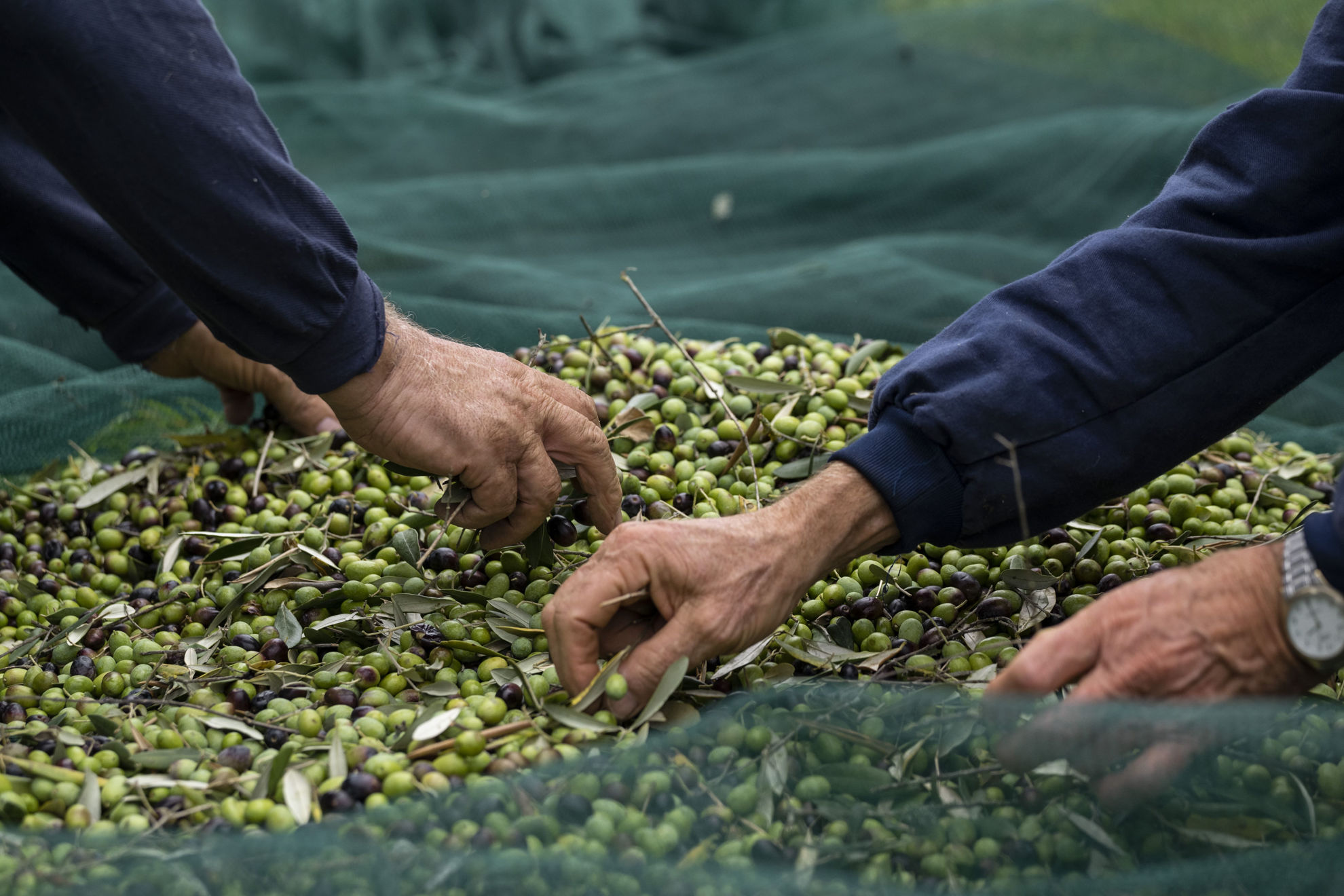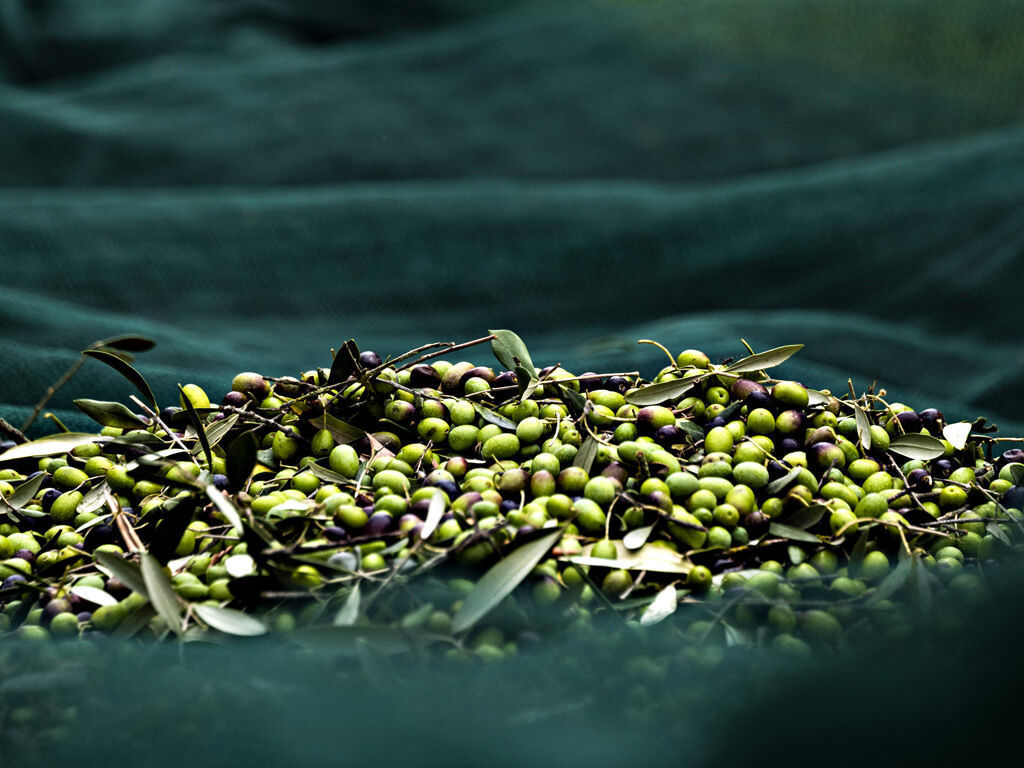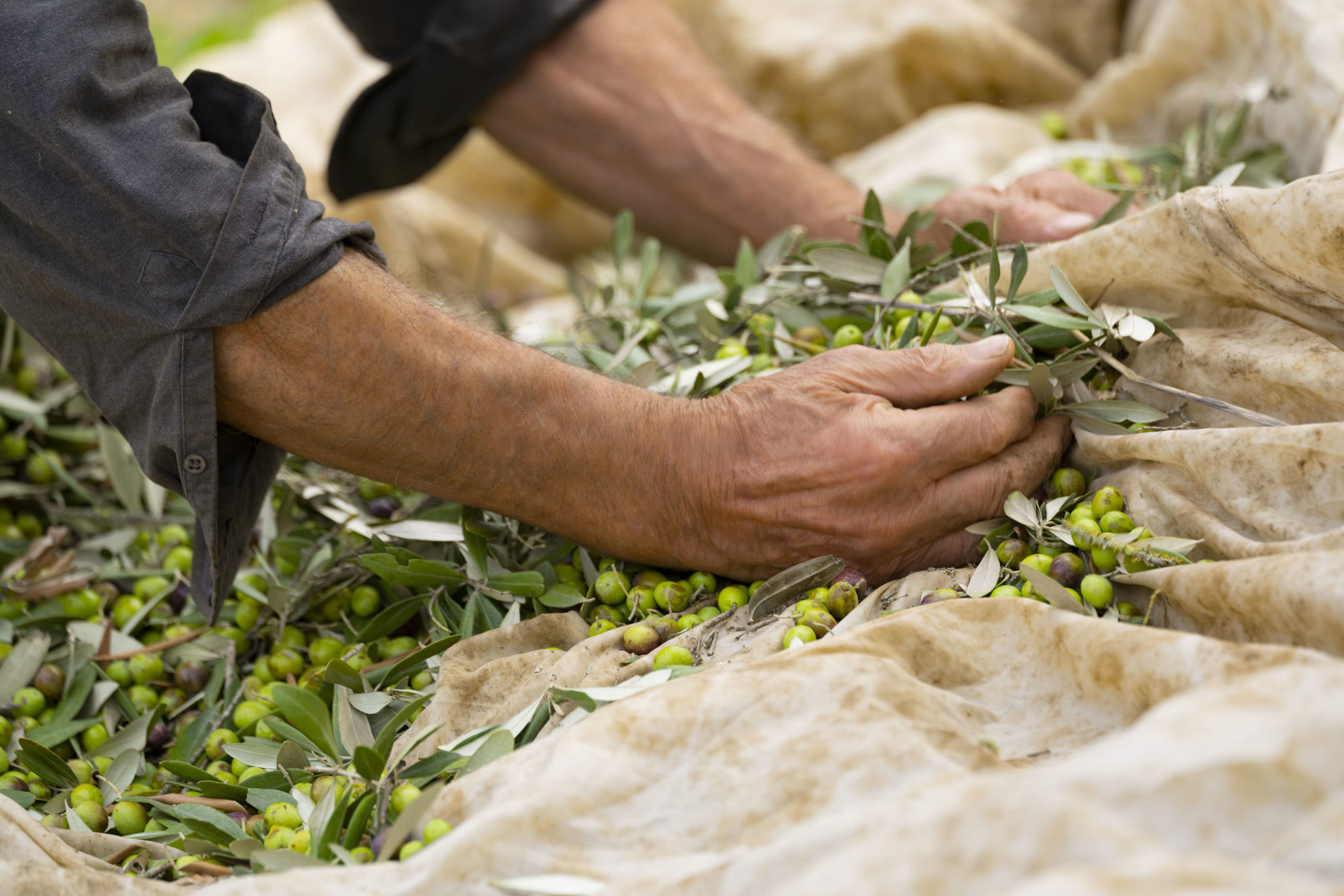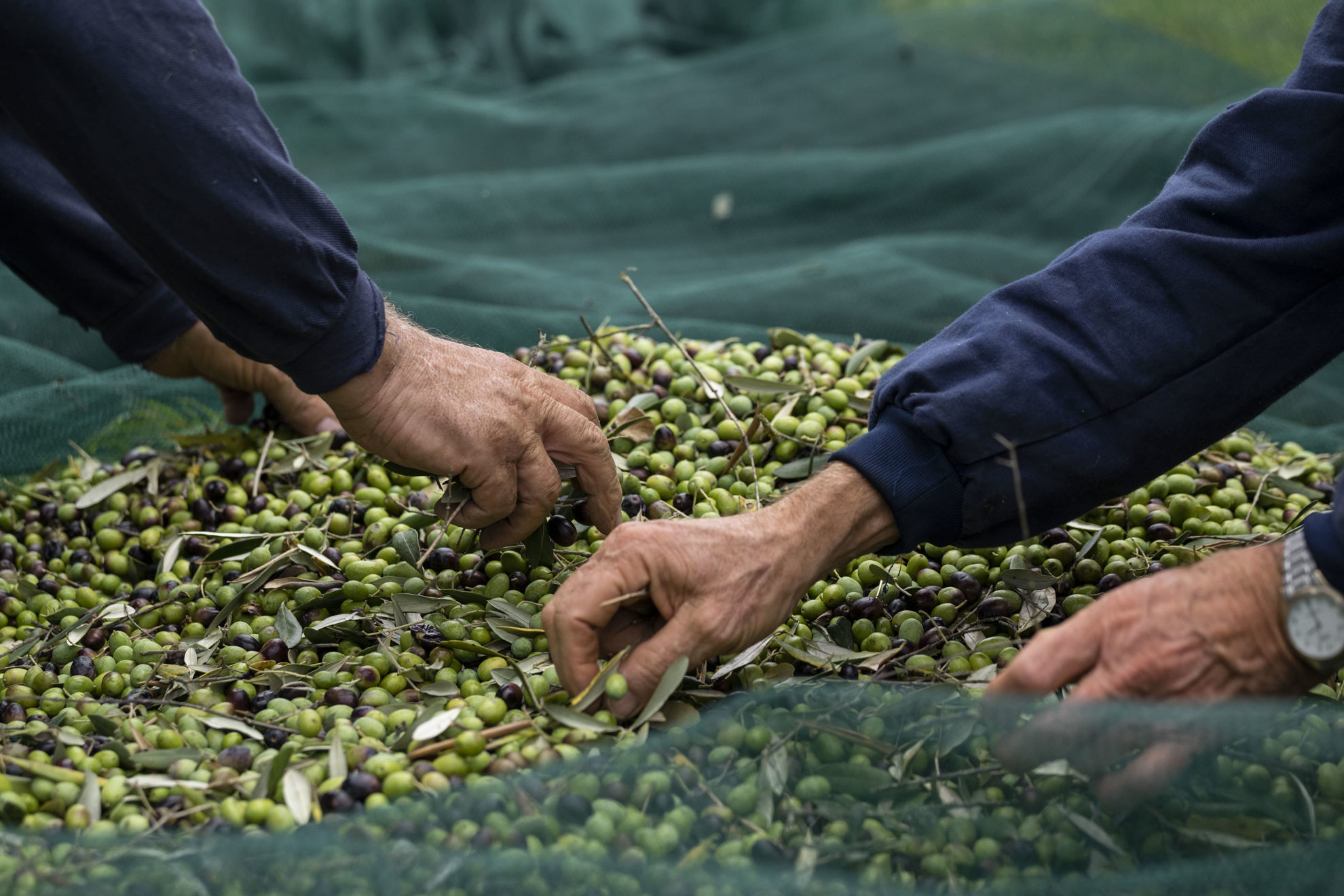
In the fascinating world of olive harvesting, two key processes take place, blending harmoniously to ensure the ideal composition of flavors, aromaticity, and numerous health properties of extra virgin olive oil. The first crucial step is the harvesting of the olives at the beginning of the olive ripening season, capturing their vivid emerald green color and fresh flavors. Immediately after, within a few hours of harvesting, the olives find their home in the Frescobaldi mill to obtain the highest quality of oil.
What is the best time for olive harvesting?
In which month are olives harvested, with what equipment, and at what degree of ripeness? The fascinating process that takes us from the olive grove to the mill is not simple: let's discover together how we manage to offer the utmost excellence in oil.
The ideal period for olive harvesting usually spans from October to the end of November, but it's important to avoid postponing it beyond November 30th. This timeframe may vary depending on various factors, such as the climate of the region where the olive trees are cultivated and the current year's weather conditions. The variety of olives (early or late ripening) and the exposure and altitude of the olive grove in relation to the sun can also influence the harvest date. Therefore, to obtain the highest quality extra virgin olive oil, it's essential to carefully consider all these elements and choose the most appropriate time for olive harvesting.
How to understand the degree of olive ripening?
Understanding the degree of ripeness of olives is essential to obtain the highest quality extra virgin olive oil. The unripe and ripe stages mark two distinct moments in the olive season, but the harvesting always takes place at the beginning of the drupes' maturation. This is the moment when the olive veraison process takes place, turning from deep green to purple, before turning completely black. It is the moment when olives veraison happens, transitioning from emerald green to purple before becoming completely black. In this way, all the valuable properties of extra virgin oil are preserved intact, thus offering an exceptional product like Laudemio Frescobaldi. In fact, the color of the olives is a good indicator of the stage of ripeness. Choosing well when to harvest the olives is critical to obtaining a quality product.
Let's explore together the different phases:
- The herbaceous phase represents the beginning of ripening, and the olives appear as small, hard, emerald green spheres. In Tuscany, the harvesting of these olives generally takes place in the first half of October, resulting in a fragrant oil with a pleasantly spicy flavor and extraordinary nutritional, organoleptic, and antioxidant properties. Harvesting at this stage significantly reduces the risk of insect infestations.
- During the veraison phase, the olives change color, transitioning from emerald green to purple. This is when the highest concentration of polyphenols occurs, making the oil of superior quality both in terms of nutrition and aroma. We can consider this the ideal moment to harvest olives destined for extra virgin olive oil.
- When the olive is fully ripe, it presents an almost black color. Although it is an ideal time for a bountiful harvest in terms of quantity, it is not always the best for those seeking exceptional quality.
- Oil obtained from overly ripe olives can be less intense in flavor, as excessive ripening leads to an increase in acidity due to fermentation. Additionally, fully ripe olives can easily fall to the ground, increasing the risk of mold and rot, which is generally avoided to obtain high-quality oil.
That is why, to ensure the highest quality of extra virgin olive oil, the harvesting of olives is done carefully and attentively during the veraison period when nature provides the right combination of flavors and beneficial properties. With the right timing and dedication, Laudemio Frescobaldi offers a unique extra virgin olive oil, perfect for enhancing every dish and satisfying the most discerning palates.



How to harvest olives?
There are several methods for harvesting olives, which can be divided into two categories: using mechanized tools or hand-picking. The key to obtaining high-quality oil is speed, as once detached from the branch, olives begin to lose their aromas and freshness. Therefore, whether choosing to harvest by hand or with the help of machinery, the main objective is to ensure a rapid milling of the still-intact olives. Attention and promptness in harvesting contribute to preserving the precious characteristics of the olives, as well as the properties and benefits of the oil, guaranteeing an excellent product.
What are the main techniques used for olive harvesting?
-
Hand harvesting of olives:
The best method to carefully select and pick olives one by one, ensuring they are not damaged and are harvested at the right degree of ripeness. This approach is the most traditional but naturally requires much more time and can be demanding. However, manual harvesting does not always guarantee high-quality oil since the time between harvesting and olive oil milling can be excessive.
-
Olive harvesting machines or shaking:
A widely used method is shaking the branches. This alternative to beating (which would damage the olives and make them unsuitable for milling) is an efficient way to save time and is particularly suitable for large olive groves where manual harvesting would be complex due to extensive areas. This work is carried out with the help of suitable and powerful machinery.
Furthermore, there are shaking and combing machines that combine the shaking and combing actions. These are widely used in more modern cultivations. This is the fastest method and, consequently, the most suitable for obtaining the highest quality oil. The speed in carrying out the harvesting allows preserving the precious characteristics of the olives and properties and benefits of olive oil, ensuring an excellent final product.
What are the threats that endanger olive production?
The harvesting method plays a crucial role in obtaining a high-quality product and has a significant impact on the goodness of the oil. If the olives are left to ripen for too long, there is a risk of increased falling and potential attacks by insects such as the olive fly and the olive moth.
Equally important is paying attention to the tools and machinery used to facilitate the work, thus avoiding damaging the precious plants. The machinery must be carefully checked and handled with awareness to prevent any harm to the olive trees and olives. Our philosophy of cultivation, respecting the environment and the land, guarantees an exceptional olive oil production process and superior quality olives.
How are freshly harvested olives preserved?
The preservation of olives becomes challenging once they have been harvested. Therefore, it is essential to take them immediately to the mill as quickly as possible to preserve their freshness and quality. For transporting the olives, using sacks is not recommended as they might get crushed and compromise their integrity. It is preferable to use crates weighing a maximum of 15 kg, so that the olives are well aerated and protected during transportation.
The promptness in processing freshly harvested olives is of fundamental importance in producing our extraordinary oil. The rapid transportation of olives to the mill on the same day of the harvest helps maintain the fresh, fragrant taste, and the quality of the oil. Thanks to this attention and care in every stage of the process, we are able to obtain exceptional extra virgin olive oil, fully expressing the unique character of our olives and resulting in a product of the highest quality. Proper storage of freshly harvested olives is the first step in successfully storing olive oil.
Conclusion: Extra virgin olive oil Laudemio Frescobaldi
By carefully selecting the ideal moment for harvesting and nurturing each stage with meticulous attention, we are able to offer an excellent extra virgin olive oil that embodies the authentic flavor of our Tuscan olives and reflects the dedication with which we are committed to producing a product of excellence. The passion for the land and attention to detail translate into a result worthy of appreciation and sharing, maximizing the richness of nature's heritage and providing an oil of the highest quality capable of enhancing culinary pleasures and capturing the hearts of those who savor it.